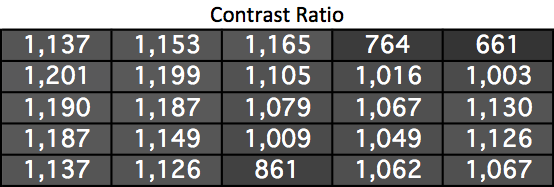ASUS MX299Q Monitor Review
by Chris Heinonen on September 23, 2013 12:00 AM ESTUniformity is measured using 25 points on the screen in CalMAN and compared to the center measurement. Since the important aspect of uniformity is how accurate the screen looks compared to itself, and not the overall error, this provides a far more accurate method of measurement.
The white uniformity of the MX299Q leaves a bit to be desired. Some areas of the screen have a 10% fall-off in brightness while others rise almost 8% relative to center. This amount of drop-off isn’t easily noticeable but is a bit higher than I would like to see.


Black uniformity suffers far more than white uniformity. The upper-right corner and lower-center have much brighter readings due to some light leakage at the border. Everywhere else has a lower black reading, which is always better, but those three zones measure poorly compared to every other reading.


Most areas of the screen wind up with a better contrast reading than the center thanks to their lower black levels. The three zones with higher black levels suffer of course, but everywhere else on the screen is between 1,009 and 1,201, providing excellent contrast results overall.


Surprisingly the areas of the screen with light leakage don’t suffer from any dE2000 errors as a result of that. Usually you would see higher errors in those areas but we don’t on the MX299Q. We do see some less-than-ideal numbers on the right side of the display when compared to the left side. The overall average still remains below the target of 3.0 overall, but some of the individual results are certain to fall above 3.0. The center and left side of the screen are excellent overall, but the right side suffers a bit on the MX299Q.

The MX299Q is overall uniform but has a couple areas of concern. The light leakage hurts the contrast ratios and the right side has some color errors as well. Most people will not notice these, but serious designers might.










44 Comments
View All Comments
dylan522p - Monday, September 23, 2013 - link
Strongly considering getting one of these and putting it in portrait as that would be much better for web content alongside my 2 1080p monitors. Anyone think that would be viable?meacupla - Monday, September 23, 2013 - link
I don't understand how 1080x2560 is better for web content, but I think your main problem would be getting this monitor in that orientation to begin with, since it doesn't look like it has any VESA mounting for an arm that can lift the screen off the table that high.Also, web content is now being made for 1280 width in mind, so wouldn't you be better off with a 2560x1440 or 2560x1600 monitor in portrait mode?
peterfares - Monday, September 23, 2013 - link
You would. These 2560x1080 monitors are basically ONLY good for movies and some games.OscarGoldman - Tuesday, September 24, 2013 - link
Except there's no delivery medium for 21:9 movies. Blu-Ray and streaming services put the image into a 16:9 frame anyway, so the only way you're going to fill a 21:9 frame is zoom into the 16:9 image. That's gonna look wonderful.michaelheath - Tuesday, September 24, 2013 - link
I wonder if you missed the first paragraph of the conclusion:"They’re also fantastic for watching movies on that are shot in scope format."
Which I would presume means Chris actually watched a film in Cinemascope. Blu Ray supports anamorphic widescreen and can map a pixel aspect ratio of 1:1, so the only worry is Netflix.
nathanddrews - Wednesday, September 25, 2013 - link
Blu-ray does NOT support anamorphic encoding. Believe me, I would be ecstatic if that were true! 16:9 is all we get whether the content is scope (2.35/39/40), 1.78, or 4:3, wrapped up in letterbox or pillarbox black bars.An upscale for a typical scope Blu-ray (actual content is ~1920x810) to one of these screens (2560x1080) isn't so terrible, really. That's only a 33% upscale. With a good scaler or scaler software, it should look fine... but does anyone really care about black bars so much that they would buy this screen?
I would buy this for gaming and that's about it, but only if it did 120Hz. Seriously, WhenTF are we going to get more 120Hz native displays?
RocketChild - Monday, September 23, 2013 - link
Asus's other 29" model like this one has VESA mounts. Model PB298QJlHADJOE - Monday, September 23, 2013 - link
longcat. 'nuff said.DanNeely - Monday, September 23, 2013 - link
I've rotated my 2560x1600 monitor a few times. It's too tall. Even with the stand at minimum the top of the screen was too high to look at without tilting my head. If you want a monitor for portrait use stick to a 20 or 22" model.spacecadet34 - Monday, September 23, 2013 - link
You don't need this tall a monitor to do what you want; I'm currently running a triple monitor setup: two 1080P's and one (rotated) Dell @ 1200x1920. Thanks to the "keyhole problem" (http://www.aristeia.com/TKP/), virtually *every* website works better in a vertical orientation. Just make sure the rotated display is an IPS, S-PVA, or similar panel that gives decent viewing angles. A TN panel would look horrible as you move your head side-to-side. Once you get used to this setup you'll never go back, unless you're into gaming.